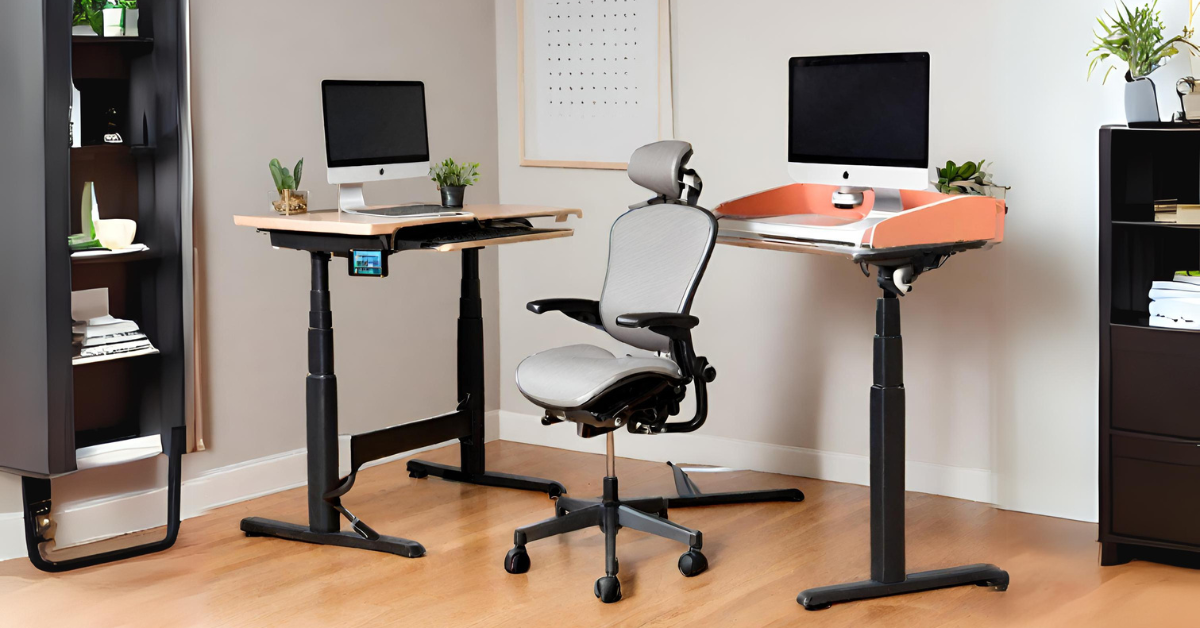In today’s fast-paced world, the significance of ergonomic furniture in modern workspaces has skyrocketed. As we spend more hours in front of screens, the need for furniture that supports our health and productivity becomes paramount.
Choosing between a new standing desk or ergonomic chair depends on your personal health needs and work style. Standing desks offer benefits like increased movement and better metabolic health, while ergonomic chairs provide crucial support for posture and reduce back pain.
Curious about how a standing desk might energize your workday or whether an ergonomic chair is the solution to your back pain? Read on to discover detailed comparisons, real user experiences, and practical tips for integrating these pieces into your workspace.
What is a Standing Desk?
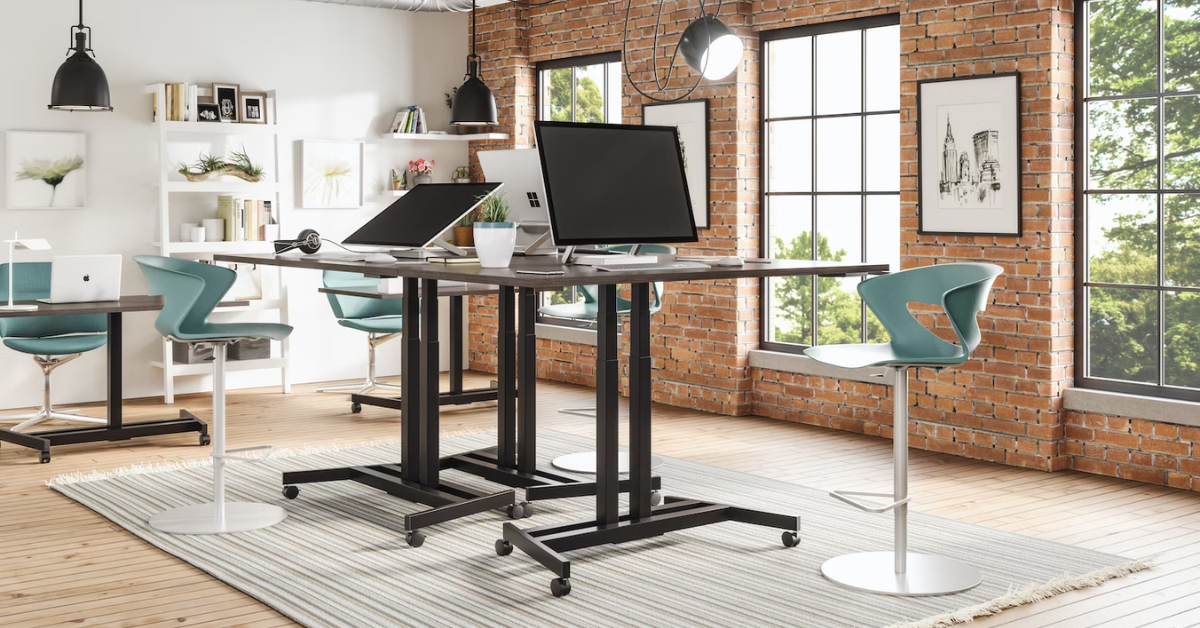
A standing desk, fundamentally, is a desk designed for use while standing. It’s a simple concept with profound implications for your work environment. These desks are not just trendy office equipment; they are tools for a healthier work lifestyle.
Historical Context and Evolution of Standing Desks
Standing desks aren’t a new invention. In fact, they’ve been used for centuries by great thinkers and leaders. Initially, they were a symbol of wealth and status, but today, they’re recognized for their health benefits and productivity boost. The evolution of standing desks reflects a growing awareness of workplace ergonomics and the importance of physical health in our daily routines.
In recent years, standing desks have evolved from rudimentary platforms to sophisticated, adjustable pieces of office furniture. This transformation is a response to the rising concern over sedentary lifestyles. Modern standing desks are designed to be ergonomic and user-friendly, catering to the diverse needs of today’s workforce.
Types of Standing Desks
Choosing the ideal desk vs. standard desk can significantly impact your comfort and productivity. Each type of the ideal standing desk caters to different needs and preferences, offering unique features and benefits. Here’s a breakdown of the various types of standing desks you might consider:
Electric Standing Desks: These desks are the epitome of convenience in height adjustment. With just a push of a button, you can seamlessly transition from sitting to standing and vice versa. Electric desks are ideal for those who frequently alternate between sitting and standing and seek a hassle-free adjustment mechanism.
Manual Standing Desks: For those looking for a more budget-friendly option, manual standing desks are a great choice. They typically use a crank or pneumatic mechanism for height adjustment. While they require more physical effort to adjust, these desks provide the same ergonomic benefits as their electric counterparts but at a more accessible price point.
L-Shaped Standing Desks: Perfect for corner spaces and larger office areas, L-shaped desks offer ample workspace. They are particularly useful for those who need multiple monitors or have extensive desk setups. These desks combine the ergonomic benefits of standing desks with the practicality of extensive surface area.
Corner Standing Desks: Similar to L-shaped desks, corner desks are designed to fit snugly into corner spaces, maximizing room efficiency. They are an excellent choice for those with limited office space but who still want the benefits of a standing desk.
Desks for Small Spaces: For those working in confined areas, desks specifically designed for small spaces are available. These compact desks often have smaller footprints but still provide the functionality and health benefits of a standard standing desk. They are perfect for home offices, apartments, or any workspace where conservation of space is key.
What is an Ergonomic Chair?
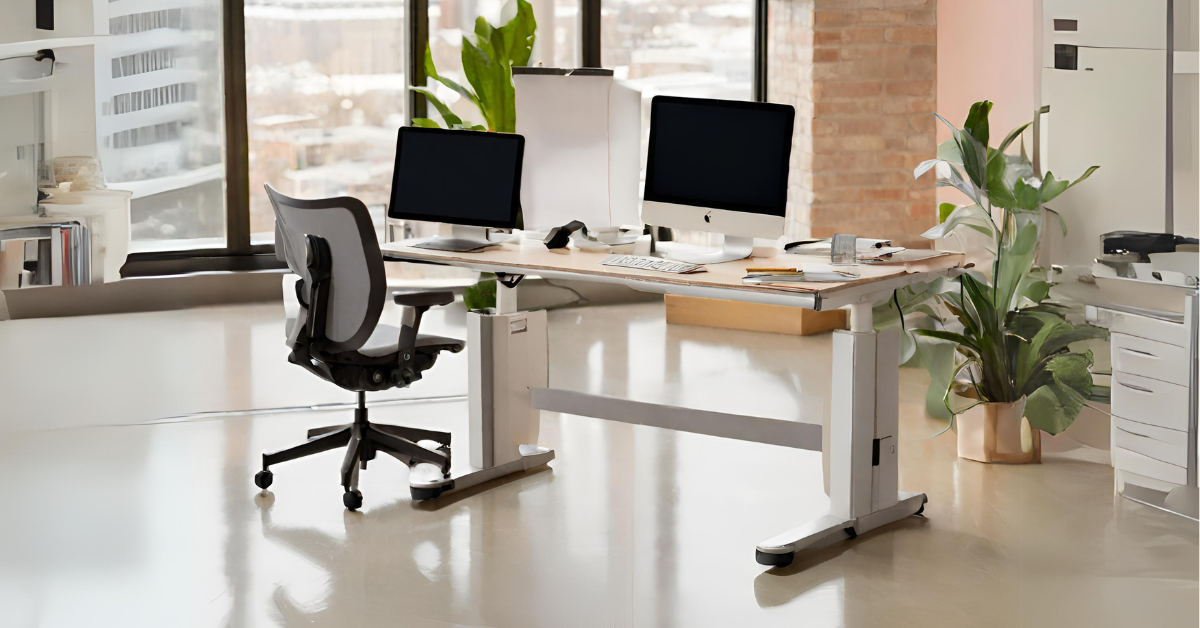
An ergonomic chair is more than just a comfortable seat. It’s a chair designed to support your body’s natural posture, reducing strain and enhancing comfort during long work hours. When selecting an office chair, considering ergonomics is crucial for your long-term health and comfort.
Comparison with Standard Office Chairs
Standard office chairs often lack the necessary support for prolonged sitting. They may lead to poor posture, resulting in back pain and other musculoskeletal issues. On the other hand, ergonomic chairs are designed with your body’s natural alignment in mind. They provide crucial support to your lower back, promote good posture, and can be adjusted to fit your unique body shape.
Comparing standard office chairs with ergonomic ones highlights the difference in support and comfort. Ergonomic chairs often feature adjustable armrests, seat depth, and lumbar support. These features ensure that you’re not only comfortable but also maintaining a posture that minimizes the risk of long-term health issues.
Varieties of Ergonomic Chairs and Adjustable Features
Ergonomic chairs come in a range of styles and configurations, each designed to cater to different preferences and body types. Understanding the various options and adjustable features available can help you find a chair that not only fits your physical requirements but also enhances your overall work experience.
Here’s a detailed look at the different varieties:
Mesh Chairs: Known for their breathability, mesh chairs keep you cool and comfortable during long hours of sitting. They are ideal for warmer climates or for those who prefer a chair with a bit of give.
Leather Chairs: Offering a classic look, leather ergonomic chairs are prized for their durability and comfort. They are often chosen for executive settings and are available in a range of styles.
Fabric Chairs: These chairs, also the one of the best chairs for bad hips, provide a soft, comfortable seating surface and are available in a wide variety of colors and patterns. Fabric chairs are a versatile choice suitable for many office environments.
Kneeling Chairs: Designed to promote an active sitting position, kneeling chairs reduce lower back strain by distributing your weight more evenly. They are a great option for those looking to improve posture.
Exercise Ball Chairs: These unique chairs encourage movement and balance, engaging your core muscles and promoting active sitting. They are an excellent choice for those looking to add a bit of fitness to their work routine.
What Makes A Chair Ergonomic?
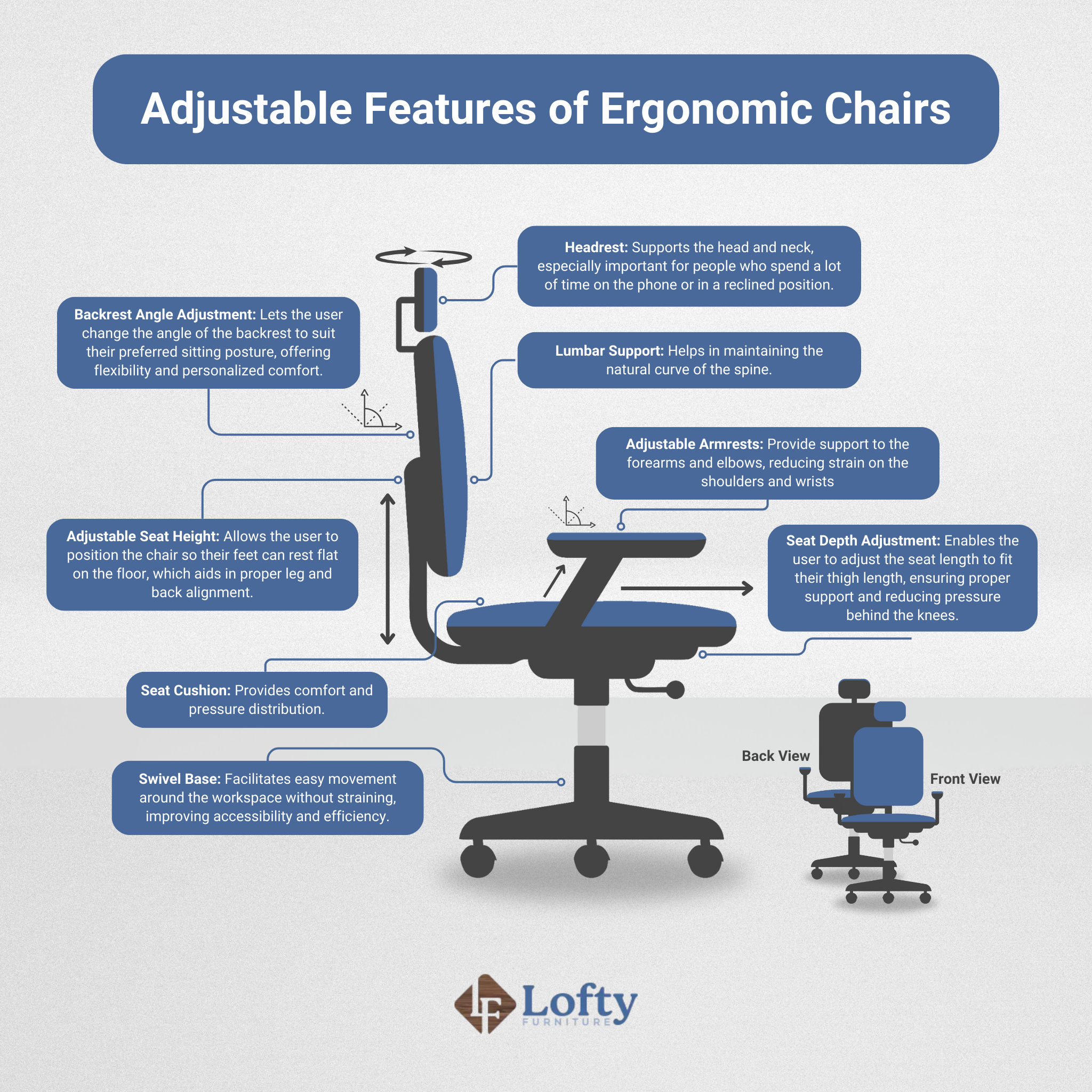
Height Adjustment: This feature allows you to adjust the chair’s height so that your feet rest flat on the ground, ensuring that your thighs are parallel to the floor. This is crucial for maintaining proper posture and reducing leg strain.
Lumbar Support Adjustment: Adjustable lumbar support helps maintain the natural curve of your spine, providing support to your lower back and reducing the risk of back pain.
Seat Depth and Width Adjustment: This feature lets you adjust the seat’s depth and width to fit your body size, ensuring that your back is supported and your legs are comfortably positioned.
Armrest Adjustment: Adjustable armrests allow you to position your arms comfortably, reducing shoulder and wrist strain. They can usually be adjusted in height and width to suit your body.
Tilt and Tension Control: These controls allow you to adjust the tilt of the chair to your preferred angle and the tension to control the amount of effort required to recline in the chair. This is important for finding a comfortable and supportive seating position.
Comparative Analysis: Standing Desks vs Ergonomic Chairs
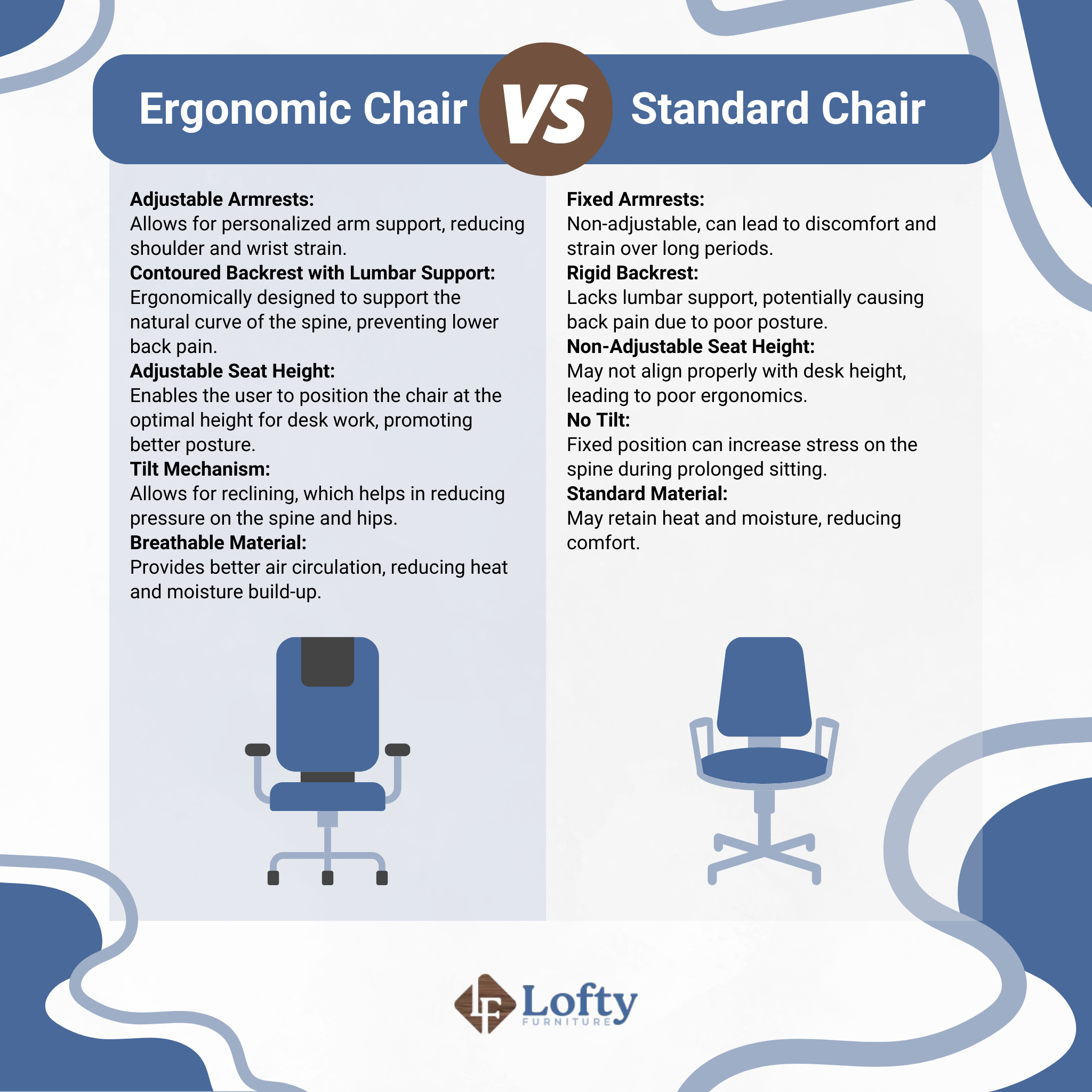
When it comes to optimizing your workspace for health and productivity, the choice between a standing desk and an ergonomic chair is a pivotal one. Understanding their distinct benefits and how they align with your personal and professional needs can guide you to make the best decision for your workspace. Let’s delve into a comparative analysis of these two essential office furniture pieces.
Overview of Key Differences
Standing desks and ergonomic chairs offer different approaches to workplace wellness. Standing desks are designed to combat the risks associated with prolonged sitting, such as poor posture, reduced circulation, and various health issues. They promote an active work style, encouraging you to stand and move regularly, which positively impacts your metabolic health and overall energy levels.
Ergonomic chairs, on the other hand, are focused on providing maximum comfort and support while seated. They are tailored to improve your posture, reduce the strain on your back and neck, and prevent the development of musculoskeletal problems. For those who spend the majority of their workday seated, an ergonomic chair is crucial in maintaining a healthy posture and avoiding long-term health issues.
Situations Where One Might Be Preferred Over the Other
Deciding between a standing desk and an ergonomic chair largely depends on your individual needs and the nature of your work environment. If you are dealing with back problems, or if your job demands prolonged periods of focus while seated, an ergonomic chair would be the preferable choice. Its design caters to supporting your back and neck, ensuring you maintain a healthy posture throughout your workday.
In contrast, if your goal is to increase physical activity and reduce the health risks of a sedentary lifestyle, a standing desk might be more suitable. It allows you to alternate between sitting and standing, helping to avoid the negative impacts of sitting for too long. Using a standing desk for a period of time can be particularly beneficial if you find that movement helps stimulate your creativity and productivity.
Health Benefits of Standing Desks
Standing desks are more than just a workplace fad; they are a proactive step towards combating the health risks associated with a sedentary lifestyle. By incorporating standing desks into your routine, you can reap multiple health benefits.
For those interested in delving deeper into the research, there are specific studies supporting these health benefits. Are standing desks really better for you? Let’s explore the specific health advantages that they offer:
Improved Posture: Regular use of standing desks encourages better posture. Standing naturally aligns your spine, neck, and head, reducing the risk of developing posture-related problems like chronic back pain. This is particularly beneficial for those who spend long hours at a desk.
Reduction in Obesity Risk: Standing burns more calories than sitting. By simply choosing to stand for portions of your workday, you can increase your daily calorie expenditure, which over time, can contribute to weight management and reduce the risk of obesity.
Decreased Risk of Heart Disease: Prolonged sitting has been linked to an increased risk of heart disease. Standing desks promote movement and better blood circulation, which is vital for heart health. Regularly alternating between sitting and standing can thus play a role in reducing the risk of heart-related conditions.
Enhanced Metabolic Health: Standing engages more muscle groups compared to sitting. This increased muscle activity helps in regulating blood sugar levels, improving your overall metabolic function. It’s particularly beneficial after meals, as it can aid in reducing blood sugar spikes.
Reduced Risk of Chronic Health Conditions: Extended periods of sitting have been linked to a higher risk of developing conditions like type 2 diabetes and certain forms of cancer. By using a standing desk, you can help mitigate these risks, as standing encourages more physical activity and less sedentary behavior.
Improved Mood and Energy Levels: Many users of standing desks, including those into gaming, report an increase in energy and mood. The act of standing and moving more frequently can lead to increased blood flow and energy, reducing feelings of fatigue and enhancing overall mood.
Increased Productivity: While this might not be a direct health benefit, it’s worth noting that many users find that standing desks boost their focus and productivity. This indirect benefit can contribute to a healthier work-life balance and overall well-being.
To get the most out of your standing desks, you might want to read more about how long you should be using one.
Advantages of Ergonomic Chairs
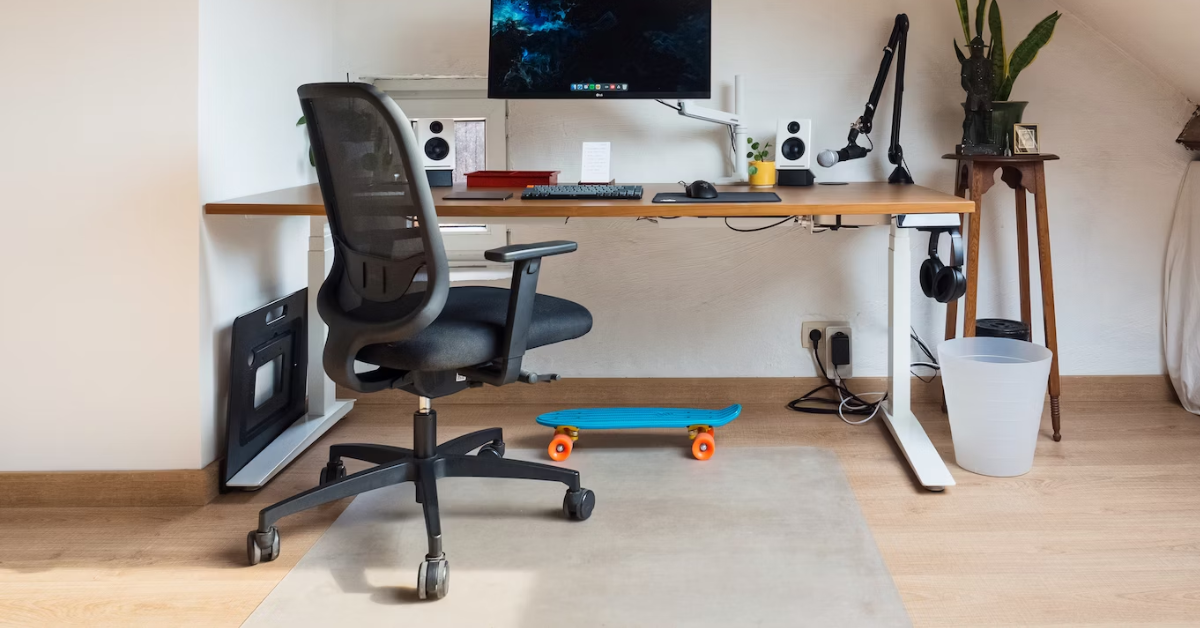
Ergonomic chairs are a crucial element in creating a healthy and comfortable workspace. They are specifically designed to support your body’s natural posture and reduce the strain caused by prolonged sitting.
Let’s take a closer look at the key advantages of ergonomic chairs, each of which contributes to a more productive and health-conscious work environment:
Supports Proper Posture: Ergonomic chairs are designed to support the natural curve of your spine. This helps in maintaining proper posture while sitting, which is essential in preventing back pain and other posture-related issues.
Reduces Back and Neck Pain: With features like adjustable lumbar support and headrests, these chairs significantly reduce the strain on your back and neck. This is especially beneficial for those who experience discomfort after sitting for extended periods.
Increases Comfort: Thanks to their adjustable features, ergonomic chairs can be customized to fit your body’s specific needs, ensuring maximum comfort throughout the workday. This customization can include adjustments in seat height, armrest height, and backrest tilt.
Enhances Productivity: When you’re comfortable and free from pain, your focus and productivity naturally improve. An ergonomic chair contributes to a more conducive work environment by allowing you to concentrate on your tasks without the distraction of discomfort.
Prevents Long-Term Health Issues: Regular use of an ergonomic chair can help prevent the development of chronic musculoskeletal problems. This is particularly important for individuals who spend the majority of their workday seated.
Adaptable to Individual Needs: The variety of adjustments available in ergonomic chairs means they can cater to a wide range of body types and preferences. This adaptability makes them suitable for a diverse workforce with varying ergonomic needs.
Improved Circulation: Proper seating posture and support encourage better blood circulation. This is crucial for maintaining energy levels and preventing the feeling of fatigue, especially during long working hours.
Cost-Effective in the Long Run: While the initial investment in an ergonomic chair might be higher than a standard office chair, the long-term benefits in reduced health issues and increased productivity make it a cost-effective choice.
Cost Comparison with Traditional Office Chairs and Standing Desks
When considering the cost, ergonomic chairs often fall between traditional office chairs and standing desks. While they may require a higher initial investment than standard chairs, ergonomic chairs offer long-term savings in healthcare costs due to their health benefits. Compared to standing desks, they are generally more affordable, making them a practical choice for those on a budget.
Still not sure which to pick? Here’s a detailed list of their pros and cons:
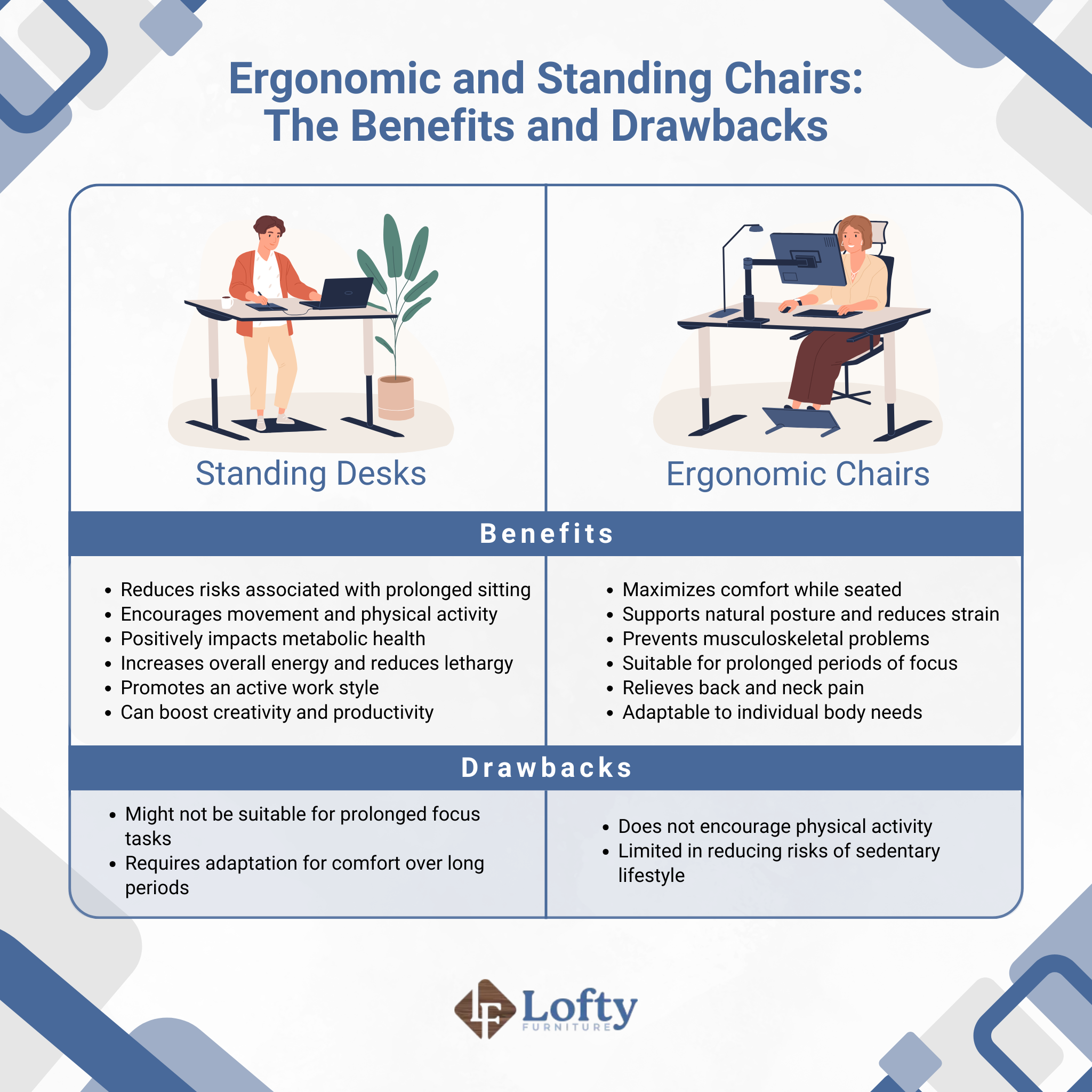
Combining Both for Optimal Health and Productivity
Combining a standing desk with an ergonomic chair in your workspace can offer the best of both worlds in terms of health and productivity. To make the most of this combination, it’s important to implement strategies that maximize the benefits of both.
Here are some effective strategies to integrate these two essential office elements seamlessly:
Adjustable Height Settings: Ensure that your standing desk can be easily adjusted to the correct height for both standing and sitting. This will allow for a smooth transition between the two and ensure ergonomic alignment in both positions.
Regular Alternation Between Sitting and Standing: Set a schedule to alternate between sitting and standing for the sake of your vein health. A common approach is to switch every hour. This routine helps in keeping your body active and reduces the risks associated with prolonged sitting or standing.
Ergonomic Chair Positioning: Position your ergonomic chair so that it’s easily accessible when you switch from standing to sitting. The chair should be adjusted to support your posture correctly when you sit down, with your feet flat on the floor and your back well-supported.
Use of Timers or Reminders: Implement the use of timers or reminder apps to prompt you to change your position. This helps in maintaining a consistent routine and ensures that you are not overexerting in either position.
Balanced Workspace Layout: Organize your workspace in a way that both your standing desk and ergonomic chair are part of an integrated system. This may involve positioning monitors, keyboards, and other tools so they are easily usable in both sitting and standing positions.
Incorporating Movement and Stretching: When alternating between sitting and standing, include brief periods of stretching or walking. This practice helps in maintaining blood circulation and reduces muscle stiffness or fatigue.
By implementing these strategies, you can enjoy the benefits of both an ergonomic chair and a standing desk, promoting a more dynamic, healthy, and productive work environment.
You might be interested to explore the best ergonomic desk chairs for home office setup.
Final Thoughts
In summary, both standing desks and ergonomic chairs offer unique benefits that can significantly enhance your health and productivity at work. The choice between the two should be based on your individual health needs, work habits, and personal preferences.
Standing desks are great for combating the sedentary lifestyle associated with office work, while ergonomic chairs are essential for providing targeted support and comfort. Combining the two can offer a comprehensive solution for a healthy and productive workspace.
For the best ergonomic setup, consider your specific needs and work environment. If you’re prone to back issues or spend long hours at a desk, an ergonomic chair is essential. If you’re looking to increase activity levels and combat the risks of prolonged sitting, a standing desk is a wise choice. For those looking to maximize health and productivity, combining both could be the optimal solution.

